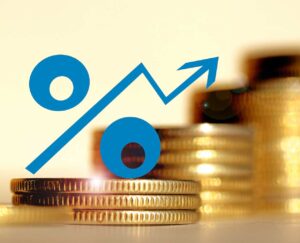Interest rates have been rising considerably for some time, making financing more expensive. But is interest the only cost component of business financing? In this blog, we look at the structure of the effective interest rate and other fees businesses pay on business loans. In the blog ‘Here’s how to influence the monthly costs of your business loan‘ we look at how you can influence these components.
Interest component
First cost is the interest rate component. When a business credit agreement has a fixed interest rate, banks look to the IRS interest rate to determine the interest component. IRS is an abbreviation for Interest Rate Swap, or in Dutch, an interest rate swap contract. In an interest rate swap, parties exchange interest payments over a predetermined term. Through such contracts, banks hedge interest rate fluctuations in their lending. The IRS interest rate used does not change during the fixed-interest period of your credit agreement.
When you take out a business loan with a variable interest rate, the interest rate you pay does change during the term. That’s because the basis for this interest rate is mobile. A common base for a variable interest rate is the Euribor rate. Euribor is a daily published rate used by banks for interest rate fixes of up to 12 months. A variable interest rate can rise or fall sharply in a short period of time.
Generally speaking; the longer the term the higher the interest rate. But with a credit with a variable interest rate, the interest expenses can rise or fall sharply in a short period of time. Even in that case, your company must be able to continue to meet the interest charges.
Risk premium
The second component of the interest rate you pay on a business loan is the risk premium or overdraft risk. When a bank lends money, there is always a risk that the money cannot be paid back. For example, in the event of bankruptcy. By charging a risk premium on all business loans, the bank can offset this loss.
The risk premium percentage, and therefore the cost, depends on the risk profile of the loan. For example, banks look at the following:
- What experience does the entrepreneur have?
- What is the size of the credit?
- In which market does the company operate?
- What will the credit be used for?
- How much of the entrepreneur’s own money can the entrepreneur bring in, and what is the entrepreneur’s equity?
- How much financial room does the company have, taking into account interest and repayment?
- What collateral can be given in relation to the requested credit?
- What is the term of the fixed rate and loan?
So together, the interest rate component and the risk premium make up the effective interest rate you have to pay. That might look like this, for example:
| IRS Rate 12 months | Risk premium | Effective interest rate business credit |
| 3,5% | 5% | 8,5% |
Other costs
In addition to interest charges, you may pay some additional fees for your business loan. These include closing commission, handling fees when making a change and/or interest penalties for an early repayment.
Finally, the credit has a repayment schedule. This could be linear over a period of 3 or 5 years, for example, or a lump sum repayment at the end of the term. Of course, the repayment component is not a cost, but rather a cash-outflow for your business. Therefore, if your company has a liquidity challenge in the coming period, then extending the repayment period may also be of interest.
How do I get what funding?
Funding, financing and entrepreneurship are inextricably linked. After all, realizing your entrepreneurial ambitions often requires capital. Consider, for example, investments in growth, innovation, capital-intensive production goods or the acquisition of a competitor.
In this e-book, we discuss finding the right financing for your plans. And with the current interest rate developments and changing role of the bank, among other things, there are more and more aspects involved. Fortunately, there are also more and more opportunities.
Download
This form is subject to our privacy policy.







